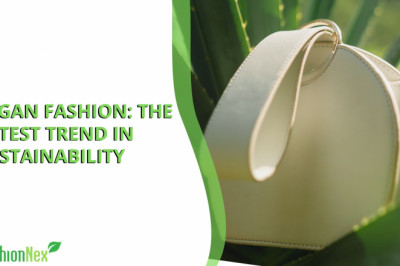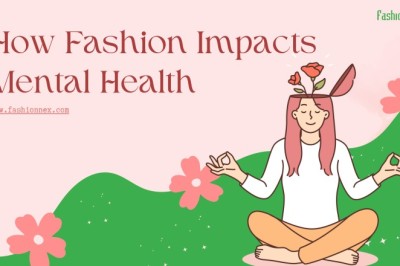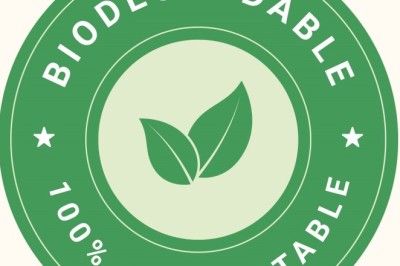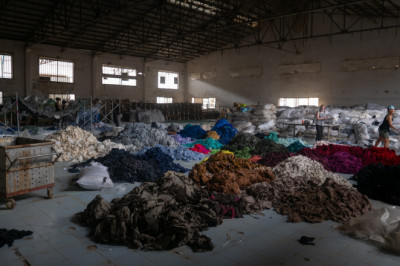views

The creation of clothing, accessories, and other fashion items ethically and responsibly is referred to as sustainable fashion. Utilizing eco-friendly materials, cutting waste, and encouraging ethical hiring practices are some examples of this. Producing sustainable fashion goods requires using sustainable materials since they have a lower environmental effect and support ethical business practices across the supply chain.
The majority of the fashion industry still uses non-sustainable materials, like conventional cotton and synthetic fabrics, despite growing awareness of and demand for sustainable fashion. This has resulted in the industry's workers being exploited and the environment being damaged. Sustainable fashion is now more accessible and practical for everyone because of substantial breakthroughs in sustainable materials and creative solutions.
Innovations In Sustainable Materials
1. Vegan leather
Vegan leather is a sustainable alternative to traditional animal-based leather made from synthetic or plant-based materials. Some common materials used to make vegan leather include pineapple leaves, mushrooms, and recycled plastic bottles.
Vegan leather has a lower environmental impact than traditional leather, as it does not require raising and slaughtering animals. Additionally, vegan leather can be produced without the harmful chemicals used in the tanning process of traditional leather.
2. Recycled polyester
Traditional polyester, which is created from post-consumer waste like plastic bottles, can be replaced with recycled polyester as a more environmentally friendly option. After being melted down, the recycled plastic is spun into polyester fibers that can be used to create apparel, accessories, and other fashionable things.
Because recycled polyester produces less waste in landfills and uses less energy and resources during production, it has a smaller environmental effect than standard polyester. It is a promising solution for sustainable fashion because it also exhibits performance traits that are comparable to those of conventional polyester.
3. Piñatex (made from pineapple leaves)
After the fruit is harvested, pineapple leaves are generally wasted, however, pinatex is a sustainable substance manufactured from those leaves. This popular substitute for conventional leather is strong, lightweight, and has a texture that is similar to leather.
Additionally, because it uses fewer resources and generates less waste than traditional leather, it has less negative influence on the environment. Piatex has grown in prominence in the fashion sector and is now employed in the creation of apparel, footwear, and accessories.
4. Orange fiber (made from citrus byproducts)
Orange peels, a byproduct of the citrus industry, are used to create orange fiber, a sustainable textile material. The fiber has a silky, soft texture that is suited for a range of fashion uses, and it is created utilizing a closed-loop method without the use of hazardous chemicals.
Orange fiber is a promising advancement in the realm of sustainable fashion since it tackles waste management difficulties and encourages the use of natural resources.
5. Econyl (made from recycled nylon)
A sustainable material known as econyl is created from recycled nylon, including waste from the plastic industry and fishing nets. The procedure entails recycling nylon waste to create fresh nylon yarn, which may then be utilized to create a range of apparel.
By using fewer natural resources and producing less Econyl than conventional nylon, less waste ends up in landfills and the oceans. Several fashion companies are utilizing it to produce eco-friendly swimwear, activewear, and other fashion goods.
6. Mycelium leather (made from fungi)
A sustainable and animal-free substitute for conventional leather derived from the mushroom's root system is mycelium leather. It grows more quickly than conventional leather and uses fewer resources.
Compared to leather generated from animals, mycelium leather is also biodegradable and has a smaller carbon footprint. It has grown in favor among designers of eco-friendly clothing, and it is anticipated that it will soon be more readily accessible.
7. Bio-based materials (made from plant-based sources)
Sustainable materials called "bio-based materials" are produced using plant-based resources like corn, sugarcane, and bamboo. Since they consume fewer resources to create and generate fewer greenhouse emissions than conventional materials, they have a much smaller impact on the environment.
Fashionable products like apparel, shoes, and accessories can be made from bio-based materials. They are also compostable and biodegradable, making them a more environmentally friendly choice than synthetic materials that cannot decompose.
Related - How to dress sustainably like Emma Watson
Advantages Of Sustainable Materials
-
Environmental benefits
There are many environmental advantages to using sustainable materials. For instance, they consume fewer non-renewable resources, create less waste during production, and release fewer hazardous chemicals and greenhouse gasses. This aids in reducing the damaging effects of fashion on the environment, such as deforestation, and air, water, and soil pollution.
-
Social benefits
Social advantages are also offered by sustainable materials. Fair labor methods are used to produce a large number of sustainable materials, supporting the livelihoods of those who work on their creation. Sustainable materials also frequently need less water and pesticides to produce than non-sustainable materials, which helps lessen the detrimental social effects of fashion on nearby communities.
-
Economic benefits
The market for sustainable materials is expanding along with the demand for eco-friendly clothing. Giving farmers, manufacturers, and other supply-chain participants the chance to develop and market sustainable resources, fosters economic growth and job prospects.
Long-term cost benefits for fashion firms can also result from the use of sustainable materials because they can decrease waste, boost productivity, and produce more lasting goods that utilize fewer resources.
Related : From Farm to Fabric: The Journey of Sustainable Clothing Materials
Fashionnex Final Words
The development of a more environmentally, socially, and commercially responsible fashion sector depends on the use of sustainable materials. Sustainable materials can contribute to a more sustainable and ethical fashion business by lowering the negative effects of fashion on the environment, enhancing fair labor practices, and promoting economic growth.
But despite the rising demand for eco-friendly clothing, non-sustainable materials continue to dominate the fashion business. Prioritizing the use of sustainable materials is crucial for fashion businesses, producers, and customers if they want to build a more sustainable and fair fashion sector.
By doing this, we may contribute to a future in which fashion is made in a way that benefits both people and the environment while still offering us the styles and goods we adore.











Comments
0 comment